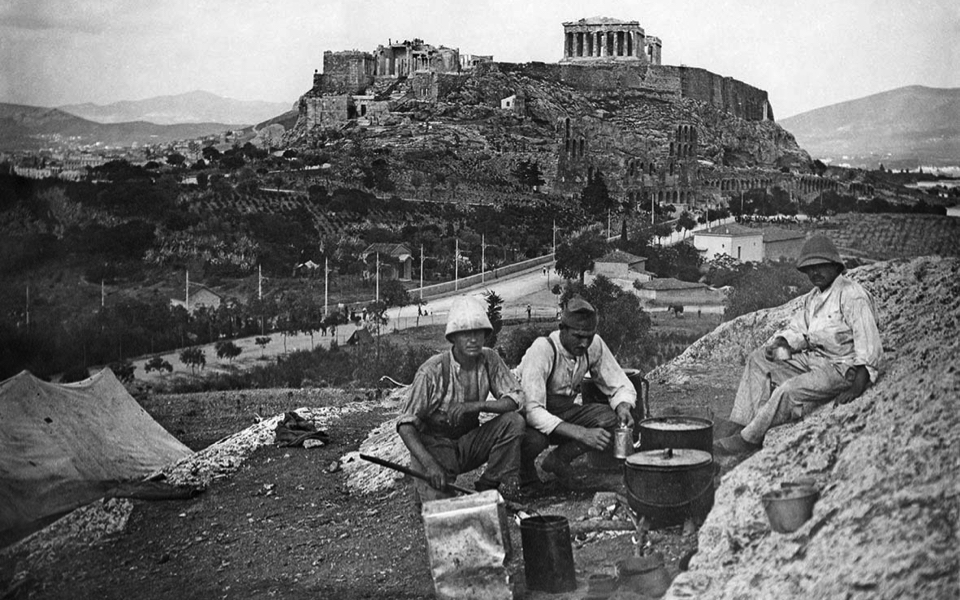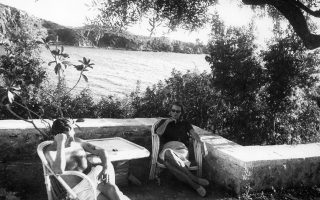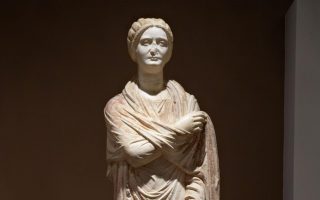Athens on the brink of the modern age, 100 years ago

Decked out in his usual top hat, Eleftherios Venizelos wipes sweat and dust from his brow with a white handkerchief in a simple gesture that heads of state were allowed to do back then, but not today. The date of this scene is June 14, 1917, and it shows Venizelos being sworn in as prime minister at Pedion tou Areos park, to lead a government that would just a couple of weeks later declare war on the Central Powers. Behind him, we see buildings that have long been erased from human memory and a sight that appears truly bizarre to the present audience: Strefi Hill, unbuilt save for a quarry on one flank, looking enormous. This image is so striking that I ask Tassos Anastasiadis, head of contemporary studies at the French School of Athens (EFA), to pause the video on his computer screen so I can take a closer look at the hill as it was 100 years ago, before being consumed by rampant construction.
We are in his office, in the beautiful buildings of the Ecole Francaise d’Athene on Didotou Street on the border between Exarchia and Kolonaki, and he is putting the finishing touches to the catalogue of a splendid exhibition organized by the school which has just gone on display at the Benaki Museum’s Pireos Street annex. “Athens 1917: Through the Eyes of the Army of the Orient” comprises 110 photographs and two videos (including the one of Venizelos’s swearing-in), and will remain on display until November 11. This is valuable material, drawn from the photographic service of the multinational allied armed forces active in the Balkans during World War I under the unified command of the Army of the Orient. The latter was established in 1915 and had its base in Thessaloniki, from where a belated attempt to support Serbia was launched. In 1917, 5,000 French troops traveled down to Athens to give their support to Venizelos after he retook power and forced King Constantine from the Greek throne. This is the first opportunity for the Athenian public to see dozens of photographs taken by two unknown French soldiers that show the capital during that period – and myriad surprises.
What we see is Athens before the arrival of hundreds of thousands of refugees from Asia Minor, with trams, carts and carriages in its streets, not to mention flocks of sheep right in the city center (responsible for stripping the city’s hills of vegetation). The houses are small and have red-tiled roofs, women are seen carrying water in clay jars and the ancient monuments exude that air more often associated with images from the Grand Tour that was so popular among Western Europeans during the Ottoman occupation. Day-to-day life, people, neighborhoods, relics of the past, buildings and streets, just as they were 100 years ago. But other than a showcase of a lesser-known part of the capital’s history, the exhibition also casts light on another chapter that has until now remained largely in the dark.
Anastasiadis explains that the WWI period was crucial for Greece, as the country was basically caught between two major conflicts: the Balkan Wars and the Greco-Turkish War. Add to this the National Schism and we understand why our knowledge of the Great War is so sorely lacking. The events before and after it were so numerous and significant that they have taken up the lion’s share of research, historical documentation and history education in Greece. For most Greeks, the Civil War and World War II appear more relevant, not because they took place later, but because there has been a lot more public discussion about them.
France, on the other hand, started designing its program of events, conferences and celebrations for the centennial of World War I in 2014. In this context, the French School set aside a four-year period of research (2016-19) to shed more light on the role of the Army of the Orient.
“We found this amazing photographic material some time ago from two sources: the Etablissement de Communication et de Production Audiovisuelle de la Defense and the Mediatheque de l’Architecture et du Patrimoine,” says Anastasiadis.
EFA has another reason to organize this exhibition: It too was in the eye of the storm in the 1915-17 period, as Greece’s pro-German King Constantine believed – and not without good reason, Anastasiadis says, smiling – that its staff included spies working for the Allies. The result was the school was closed for six months after the crisis of the Greek Vespers (Noemvriana, or November events, in the Julian calendar then in use in Greece) of 1916, when the royalist government clashed with the Allies.
Anastasiadis adds, however, that the aim of the exhibition is not just to showcase events in the theater of war, but also to highlight a slew of important milestones. Few people, for example, know that hundreds of Africans and Asians from the colonies came to Greece for the first time with the army. Greeks who were only familiar with the different ethnicities that existed within the country during the Ottoman occupation were suddenly introduced to people, customs and traditions they had never seen before. It is worth noting that at one point the number of troops in Thessaloniki came to 650,000.
When the 5,000 French troops came to Athens for Venizelos, King Constantine was forced to capitulate on the issue of Greece’s neutrality in the war – thanks also to the naval blockades, of course.
“The Army of the Orient was known by some by the derogatory term ‘the gardeners of Thessaloniki’ because they believed it did not fight hard enough against the enemy, but the fact is that this army contributed to the treaty with Bulgaria that changed the course of the war,” says Anastasiadis. “The truth is that this is a fascinating story and we are very excited that Athenians have the opportunity to see these photographs.”
Benaki Museum, 138 Pireos, www.benaki.gr. Opening hours are Thursdays and Sundays from 10 a.m. to 6 p.m. and Fridays and Saturdays from 10 a.m. to 10 p.m.





